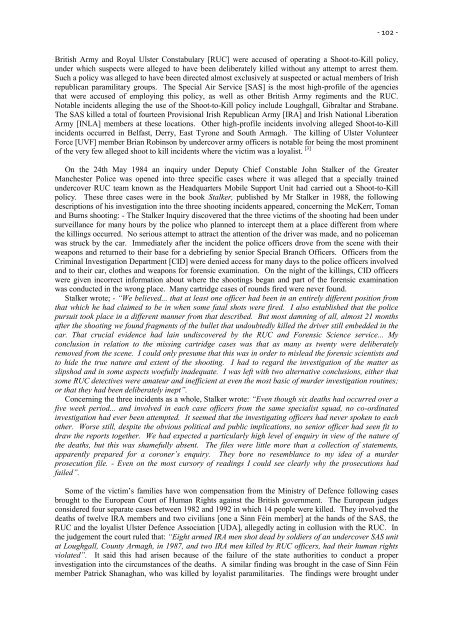TRAPPED IN A MASONIC WORLD
TRAPPED IN A MASONIC WORLD
TRAPPED IN A MASONIC WORLD
You also want an ePaper? Increase the reach of your titles
YUMPU automatically turns print PDFs into web optimized ePapers that Google loves.
- 102 -<br />
British Army and Royal Ulster Constabulary [RUC] were accused of operating a Shoot-to-Kill policy,<br />
under which suspects were alleged to have been deliberately killed without any attempt to arrest them.<br />
Such a policy was alleged to have been directed almost exclusively at suspected or actual members of Irish<br />
republican paramilitary groups. The Special Air Service [SAS] is the most high-profile of the agencies<br />
that were accused of employing this policy, as well as other British Army regiments and the RUC.<br />
Notable incidents alleging the use of the Shoot-to-Kill policy include Loughgall, Gibraltar and Strabane.<br />
The SAS killed a total of fourteen Provisional Irish Republican Army [IRA] and Irish National Liberation<br />
Army [<strong>IN</strong>LA] members at these locations. Other high-profile incidents involving alleged Shoot-to-Kill<br />
incidents occurred in Belfast, Derry, East Tyrone and South Armagh. The killing of Ulster Volunteer<br />
Force [UVF] member Brian Robinson by undercover army officers is notable for being the most prominent<br />
of the very few alleged shoot to kill incidents where the victim was a loyalist. [3]<br />
On the 24th May 1984 an inquiry under Deputy Chief Constable John Stalker of the Greater<br />
Manchester Police was opened into three specific cases where it was alleged that a specially trained<br />
undercover RUC team known as the Headquarters Mobile Support Unit had carried out a Shoot-to-Kill<br />
policy. These three cases were in the book Stalker, published by Mr Stalker in 1988, the following<br />
descriptions of his investigation into the three shooting incidents appeared, concerning the McKerr, Toman<br />
and Burns shooting: - The Stalker Inquiry discovered that the three victims of the shooting had been under<br />
surveillance for many hours by the police who planned to intercept them at a place different from where<br />
the killings occurred. No serious attempt to attract the attention of the driver was made, and no policeman<br />
was struck by the car. Immediately after the incident the police officers drove from the scene with their<br />
weapons and returned to their base for a debriefing by senior Special Branch Officers. Officers from the<br />
Criminal Investigation Department [CID] were denied access for many days to the police officers involved<br />
and to their car, clothes and weapons for forensic examination. On the night of the killings, CID officers<br />
were given incorrect information about where the shootings began and part of the forensic examination<br />
was conducted in the wrong place. Many cartridge cases of rounds fired were never found.<br />
Stalker wrote; - ―We believed... that at least one officer had been in an entirely different position from<br />
that which he had claimed to be in when some fatal shots were fired. I also established that the police<br />
pursuit took place in a different manner from that described. But most damning of all, almost 21 months<br />
after the shooting we found fragments of the bullet that undoubtedly killed the driver still embedded in the<br />
car. That crucial evidence had lain undiscovered by the RUC and Forensic Science service... My<br />
conclusion in relation to the missing cartridge cases was that as many as twenty were deliberately<br />
removed from the scene. I could only presume that this was in order to mislead the forensic scientists and<br />
to hide the true nature and extent of the shooting. I had to regard the investigation of the matter as<br />
slipshod and in some aspects woefully inadequate. I was left with two alternative conclusions, either that<br />
some RUC detectives were amateur and inefficient at even the most basic of murder investigation routines;<br />
or that they had been deliberately inept‖.<br />
Concerning the three incidents as a whole, Stalker wrote: ―Even though six deaths had occurred over a<br />
five week period... and involved in each case officers from the same specialist squad, no co-ordinated<br />
investigation had ever been attempted. It seemed that the investigating officers had never spoken to each<br />
other. Worse still, despite the obvious political and public implications, no senior officer had seen fit to<br />
draw the reports together. We had expected a particularly high level of enquiry in view of the nature of<br />
the deaths, but this was shamefully absent. The files were little more than a collection of statements,<br />
apparently prepared for a coroner‘s enquiry. They bore no resemblance to my idea of a murder<br />
prosecution file. - Even on the most cursory of readings I could see clearly why the prosecutions had<br />
failed‖.<br />
Some of the victim‘s families have won compensation from the Ministry of Defence following cases<br />
brought to the European Court of Human Rights against the British government. The European judges<br />
considered four separate cases between 1982 and 1992 in which 14 people were killed. They involved the<br />
deaths of twelve IRA members and two civilians [one a Sinn Féin member] at the hands of the SAS, the<br />
RUC and the loyalist Ulster Defence Association [UDA], allegedly acting in collusion with the RUC. In<br />
the judgement the court ruled that: ―Eight armed IRA men shot dead by soldiers of an undercover SAS unit<br />
at Loughgall, County Armagh, in 1987, and two IRA men killed by RUC officers, had their human rights<br />
violated‖. It said this had arisen because of the failure of the state authorities to conduct a proper<br />
investigation into the circumstances of the deaths. A similar finding was brought in the case of Sinn Féin<br />
member Patrick Shanaghan, who was killed by loyalist paramilitaries. The findings were brought under












![[Pham_Sherisse]_Frommer's_Southeast_Asia(Book4You)](https://img.yumpu.com/38206466/1/166x260/pham-sherisse-frommers-southeast-asiabook4you.jpg?quality=85)




